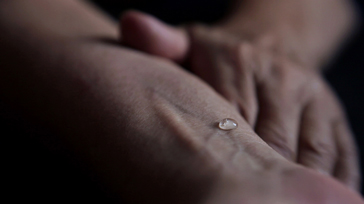
Born in Tunis(TN) in 1978. Lives and works in Paris(FR), Lyon(FR) and Tunis(TN).

2011
Video, color, sound
Durée : 1'
Year of Purchase: 2012
What can we see in the intermittence, retention, and depletion of a drop of water that travels along a stretch of sewing thread (Coulée douce, 2007)? What can we see in the regular, imperceptible rhythm of another drop, sparkling like a pearl, a nearly perfect sphere of liquid, that palpitates at the faint contact of a human pulse (Ligne, 2011)? What can we see in the mysterious encounter, at first blurred, ill-defined, with a shadowy body slowly approaching the lens of the video camera? Or in the hands patiently occupied, against the precise symmetry of a snow-covered surface, with the simple task of rolling up and untangling a black thread, aware, in the time of the progression of the video image, of each tension and slackening that is gently, accidentally effected by those hands (Dénouement, 2011)? Duration. The time of an innocuous phenomenon and its image. The precise significance and subtlety of the detail revealing the hidden, indistinct, and ephemeral visible. The measure of the span of vision. In Ismaïl Bahri’s work there is a dual, concomitant memory of the pictorial gesture and of the cinematic gesture, as well as a rare experience of the slowness of things and gestures staged by means of small devices or experimental protocols which make it possible to observe how they form in a presence revealed within the folds and cracks uncovered in the visible. This slowness is also needed so that the form may not only rise to the surface of the skin of the world as unexpected, uninhibited micro-events, but also so that, at a given moment, it produces a new image, a possible work. Experimentation is undoubtedly one of the key properties of Ismaïl Bahri’s work—whether it’s drawing, photography, an in situ installation, or video.
A graduate of the Institut des Beaux-Arts in Tunis (1996–2000) and a Ph.D. in Arts and Humanities at Paris I-Sorbonne (2002–2005), Ismaïl Bahri positions his work at the juncture of experimentation, of the infinitesimal, and of the relation, at the point of contact, between touch and the diffusion of simple, ordinary matters and elements: drops of water (Ligne, Coulée douce, and in all the devices refined and expanded for installation since the 2007 video), milk (the drawings in Latence, 2010), ink (the photographs in Sang d’encre, or a stroll through the streets of Tunis, through a black “screen” of ink capturing snippets of images and light in Orientation, 2010). Capricious wind and pulsations made perceptible by the presence of a sheet of white paper placed in front of the camera in the videos Éclipses, Chants, and Percées, made in 2014–2015, where the gaze is being covered and uncovered by rhythmic blows of random breath. This piece of paper is, like skin, like the sewing thread, or like a glass plate, among the receptor surfaces used by Bahri. Receptors of fluidity, capillarity, dilations, contiguities, these are optical and sensory “intercessors” between the object, the image, the form, and the gaze returned to its condition of the gaze, that is, imperfect, uncertain, and expectant.
Marjorie Micucci